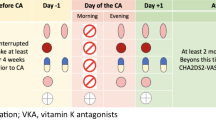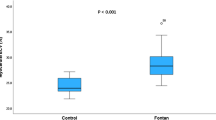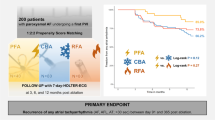Abstract
Enhanced computed tomography (CT) is unsuitable for patients with reduced renal function and/or allergy for contrast medium (CM). CT image registration into an electroanatomic system (EAMS) is essential to perform pulmonary vein isolation (PVI) safely and smoothly in patients with atrial fibrillation (AF). To create three-dimensional pulmonary vein-left atrium (3D PV-LA) images from non-enhanced CT images to register them into EAMS for AF ablation. Using a non-enhanced ECG-gated image, 3D PV-LA images were generated by our developed techniques with an EnSite image analyzing tool for patients unfit for CM use (n = 100). Segmentation between tissues was performed as follows: tissues distal from or close to PV-LA were segmented in transverse slices to clearly show the whole LA. Tissues bordering PV-LA, including the pulmonary artery, left ventricle, and right atrium, were segmented manually with great care. Practical ablation parameters were compared with those obtained from enhanced CT (n = 100). 3D PV-LA image reconstruction from non-enhanced CT imaging required a longer time than that from enhanced CT (42 ± 6 vs 14 ± 3 min). All 100 PV-LA non-enhanced CT images were successfully reconstructed and registered into the EAM system without the need for re-segmentation. Practical ablation parameters, including procedural time and AF recurrence rate, did not differ between imaging methods. This study provides clinically useful information on a detailed methodology for 3D PV-LA image reconstruction using non-enhanced CT. Non-enhanced CT 3D PV-LA images were successfully registered into the EAM system and useful for patients unsuitable for CM use.






Similar content being viewed by others
Data availability
The data that support the findings of this study are available from the corresponding author, S.K., upon reasonable request.
Abbreviations
- AF:
-
Atrial fibrillation
- AT:
-
Atrial tachycardia
- CE:
-
Contrast medium
- CT:
-
Computed tomography
- EAMS:
-
Electroanatomical mapping system
- LA:
-
Left atrium
- PA:
-
Pulmonary artery
- PV:
-
Pulmonary vein
- PVI:
-
Pulmonary vein isolation
- RA:
-
Right atrium
- RV:
-
Right ventricle
References
Miyasaka Y, Barnes ME, Gersh BJ, Cha SS, Bailey KR, Abhayaratna WP et al (2006) Secular trends in incidence of atrial fibrillation in Olmsted County, Minnesota, 1980 to 2000, and implications on the projections for future prevalence. Circulation 114:119–125
Benjamin EJ, Wolf PA, D’Agostino RB, Silbershatz H, Kannel WB, Levy D (1998) Impact of atrial fibrillation on the risk of death: the Framingham Heart Study. Circulation 98:946–952
Calkins H, Kuck KH, Cappato R, Brugada J, Camm AJ, Chen SA et al (2012) 2012 HRS/EHRA/ECAS expert consensus statement on catheter and surgical ablation of atrial fibrillation: recommendations for patient selection, procedural techniques, patient management and follow-up, definitions, endpoints, and research trial design. J Interv Card Electrophysiol 33:171–257
Calkins H, Hindricks G, Cappato R, Kim YH, Saad EB, Aguinaga L et al (2018) 2017 HRS/EHRA/ECAS/APHRS/SOLAECE expert consensus statement on catheter and surgical ablation of atrial fibrillation: executive summary. Europace 20:157–208
Lacomis JM, Wigginton W, Fuhrman C, Schwartzman D, Armfield DR, Pealer KM (2003) Multi-detector row CT of the left atrium and pulmonary veins before radio-frequency catheter ablation for atrial fibrillation. Radiographics. https://doi.org/10.1148/rg.23si035508
Tang K, Ma J, Zhang S, Zhang JY, Wei YD, Chen YQ et al (2008) A randomized prospective comparison of CartoMerge and CartoXP to guide circumferential pulmonary vein isolation for the treatment of paroxysmal atrial fibrillation. Chin Med J (Engl) 121:508–512
Kettering K, Greil GF, Fenchel M, Kramer U, Weig HJ, Busch M et al (2009) Catheter ablation of atrial fibrillation using the Navx-/Ensite-system and a CT-/MRI-guided approach. Clin Res Cardiol 98:285–296
Pappone C, Oreto G, Lamberti F, Vicedomini G, Loricchio ML, Shpun S et al (1999) Catheter ablation of paroxysmal atrial fibrillation using a 3D mapping system. Circulation 100:1203–1208
Yamaji H, Hina K, Kawamura H, Murakami T, Murakami M, Hirohata S et al (2012) Sufficient pulmonary vein image quality of non-enhanced multi-detector row computed tomography for pulmonary vein isolation by catheter ablation. Europace 14:52–59
Isaka Y, Hayashi H, Aonuma K, Horio M, Terada Y, Doi K et al (2020) Guideline on the use of iodinated contrast media in patients with kidney disease 2018. Clin Exp Nephrol 24:1–44
Mehran R, Aymong ED, Nikolsky E, Lasic Z, Iakovou I, Fahy M et al (2004) A simple risk score for prediction of contrast-induced nephropathy after percutaneous coronary intervention: development and initial validation. J Am Coll Cardiol 44:1393–1399
Halliburton SS, Abbara S, Chen MY, Gentry R, Mahesh M, Raff GL et al (2011) SCCT guidelines on radiation dose and dose-optimization strategies in cardiovascular CT. J Cardiovasc Comput Tomogr 5:198–224
Matsunaga Y, Chida K, Kondo Y, Kobayashi K, Kobayashi M, Minami K et al (2019) Diagnostic reference levels and achievable doses for common computed tomography examinations: results from the Japanese nationwide dose survey. Br J Radiol 92:20180290
Richmond L, Rajappan K, Voth E, Rangavajhala V, Earley MJ, Thomas G et al (2008) Validation of computed tomography image integration into the EnSite NavX mapping system to perform catheter ablation of atrial fibrillation. J Cardiovasc Electrophysiol 19:821–827
Yamaji H, Murakami T, Hina K, Higashiya S, Kawamura H, Murakami M et al (2013) Usefulness of dabigatran etexilate as periprocedural anticoagulation therapy for atrial fibrillation ablation. Clin Drug Investig 33:409–418
Lee G, Sparks PB, Morton JB, Kistler PM, Vohra JK, Medi C et al (2011) Low risk of major complications associated with pulmonary vein antral isolation for atrial fibrillation: results of 500 consecutive ablation procedures in patients with low prevalence of structural heart disease from a single center. J Cardiovasc Electrophysiol 22:163–168
Shigenaga Y, Kiuchi K, Okajima K, Ikeuchi K, Ikeda T, Shimane A et al (2015) Acquisition of the pulmonary venous and left atrial anatomy with non-contrast-enhanced MRI for catheter ablation of atrial fibrillation: usefulness of two-dimensional balanced steady-state free precession. J Arrhythm 31:189–195
Aouad P, Koktzoglou I, Milani B, Serhal A, Nazari J, Edelman RR (2020) Radial-based acquisition strategies for pre-procedural non-contrast cardiovascular magnetic resonance angiography of the pulmonary veins. J Cardiovasc Magn Reson 22:78
Acknowledgements
None.
Funding
This research did not receive any specific grant from funding agencies in the public, commercial, or not-for-profit sectors.
Author information
Authors and Affiliations
Contributions
Made substantial contributions to the conception or design of the work; or the acquisition, analysis, or interpretation of data; or the creation of new software used in the work: SK, HY, MK, AA, MM, TT, TK, TA, and SK. Drafted the work or revised it critically for important intellectual content: SK, HY, SH, TM, and SK. All authors approved this version of the manuscript to be published.
Corresponding author
Ethics declarations
Conflict of interest
There are no conflicts of interest in connection with the present study.
Ethical approval
The examination and analytical procedures adhered to the principles of the Declaration of Helsinki, and the study was approved by the Institutional Ethics Committee for Human Research of Okayama Heart Clinic. Written informed consent for the use of data without personally identifiable information was obtained from all patients.
Additional information
Publisher's Note
Springer Nature remains neutral with regard to jurisdictional claims in published maps and institutional affiliations.
Rights and permissions
Springer Nature or its licensor (e.g. a society or other partner) holds exclusive rights to this article under a publishing agreement with the author(s) or other rightsholder(s); author self-archiving of the accepted manuscript version of this article is solely governed by the terms of such publishing agreement and applicable law.
About this article
Cite this article
Kawafuji, S., Yamaji, H., Kayama, M. et al. Usefulness of three-dimensional pulmonary vein-left atrium image reconstructed from non-enhanced computed tomography for atrial fibrillation ablation. Int J Cardiovasc Imaging 39, 2517–2526 (2023). https://doi.org/10.1007/s10554-023-02943-6
Received:
Accepted:
Published:
Issue Date:
DOI: https://doi.org/10.1007/s10554-023-02943-6




